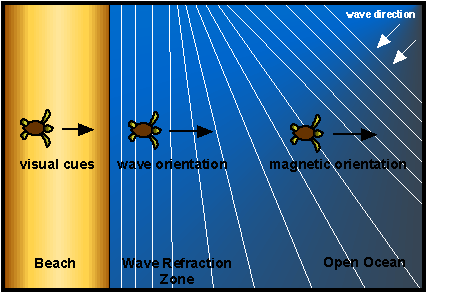The Offshore Migration
Hatchling loggerhead sea turtles from eastern
Florida, U.S.A., use three different sets of orientation cues sequentially
as they migrate offshore to the Gulf Stream. Hatchlings that have just emerged from their
underground nests on the beach crawl seaward by orienting toward the low,
bright oceanic horizon. Once turtles enter the ocean, they initially establish
an offshore heading by swimming into waves. Because waves are refracted
in shallow, coastal areas until they approach the beach directly, swimming
into waves reliably leads turtles seaward.
In deeper water farther from land, waves
can move in any direction relative to the coastline and no longer provide
a reliable indicator of offshore direction. Nevertheless, hatchlings tracked
from a Florida beach into the open ocean continued on the same seaward
headings after entering offshore areas where wave direction no longer coincided
with their established courses. Experiments have revealed that hatchlings
can transfer a course initiated on the basis of wave cues to a course maintained
by a magnetic compass. This transfer of directional information may enable
turtles to maintain offshore headings even after swimming beyond the wave
refraction zone.

The diagram above summarizes the orientation
cues that are thought to guide hatchling Florida loggerheads from their
nests to the Gulf Stream Current. The beach is to the left and progressively
deeper water is to the right. Lines represent oceanic waves moving toward
the beach; as they enter shallow coastal areas, waves refract until they
approach the beach directly.
Click on the three turtles in the diagram
to learn more about how hatchlings guide themselves during each part of
the migration.